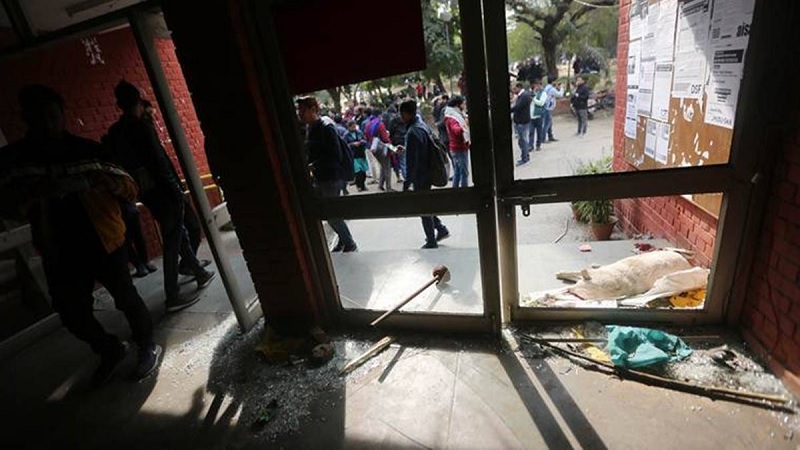 Image Courtesy:indianexpress.com
Image Courtesy:indianexpress.com
The Delhi Police ‘fact-finding committee’ has unearthed facts that prove Delhi Police’s claims that Delhi Police innocent of all charges of negligence in connection with the widely reported violence that took place in the Jawaharlal Nehru University campus on January 5 2020!
Basically, Delhi Police has given itself a clean chit, yet again, reported The Indian Express. This time Delhi Police reached the conclusion after the report of a ‘fact-finding committee’, it formed to “probe the sequence of events” and “negligence on part of local police” when around 100 masked persons went on a rampage, armed with sticks and metal rods inside the JNU campus for around four hours on January 5. The arson and violence had left 36 students, teachers and staff injured. According to the IE an FIR was registered, and the case was subsequently transferred to the Crime Branch, however no arrest has been made so far.
The violence and its aftermath was widely reported and many raised the basic question as to why the well trained to respond Delhi Police force chose to remain outside the campus even though violence continued to rage inside. As reported by IE and all other media outlets, this inaction of the Delhi Police was in sharp contrast to police action at Jamia Millia Islamia weeks earlier, in December 2019. At Jamia, the Delhi Police had barged into the campus and allegedly beaten up students inside the library. However, the Delhi Police have maintained that while they had “entered Jamia to chase down rioters, they couldn’t enter JNU without the assent of the university authorities” recalled the IE report.
Here’s what happened at JNU that day: Masked people, allegedly Akhil Bharatiya Vidyarthi Parishad (ABVP) members invaded the campus with lathis and rods and launched a murderous attack on JNU students. Even though the mainstream media conveniently called it clashes between ABVP and JNU Students Union, images from JNU told a completely different story. The attack started at 6:30 in the evening when masked men armed with lathis, rods and sledgehammers entered the campus terrorist style and attacked JNUSU representatives. They entered hostels (girls hostel included) and smashed furniture and beat up students and teachers inside the campus.
Questions were raised over the alleged inaction by Delhi Police when the violence raged inside one the top universities of the country, located in the National Capital. “How did it allow the goons to enter the campus and then let them go? Why have none of them been arrested even when most of the media has openly carried reports of planned action allegedly by the ABVP members in Delhi University?”
Eventually the Delhi Police set up a committee, headed by Joint Commissioner of Police (Western Range) Shalini Singh, on the instructions of then Police Commissioner Amulya Patnaik, and comprising four inspectors and two ACPs. According to the IE report, the committee recorded statements of then DCP (south-west) Devender Arya, then ACP Ramesh Kakkar, SHO Vasant Kunj (North) Rituraj, and Inspector Anand Yadav, who was stationed at the administrative block on the morning of January 5 following the High Court’s directions to deploy personnel to ensure protests do not happen within a 100-metre radius of the block where the Vice-Chancellor sits, added the news report.
The IE reported that that all police personnel gave similar statements while explaining the sequence of events from 8 AM on January 5, when 27 police personnel in plainclothes, including women, arrived for duty at the JNU Administration Block and relieved the night shift. It added a comment from a senior Delhi Police officer who chose to remain anonymous that “Their job was to ensure compliance with the High Court order directing police to ensure that no dharna or protest takes place within 100 metres of the admin block. All those police personnel did not have any weapons or lathis. The PCR call started from 2.30 PM and in total, 23 calls were made from inside the campus to the police.”
The committee’s report mentioned that eight PCR calls were made from 3.45 PM to 4.15 PM, which were mainly related to beating of students at Periyar hostel. Later, 14 PCR calls, about isolated incidents of quarrels and gathering by students, were made from 4.15 PM to 6 PM, reported IE. “DCP Arya visited the campus along with his subordinates around 5-5.15 PM, but returned to the main gate as the situation appeared normal at the time. The officials during enquiry also showed Vice-Chancellor M Jagadesh Kumar’s WhatsApp message, which was sent at 6.24 PM to Arya, the ACP and the SHO, asking them to be stationed at the gates. At 7.45 PM, Registrar Pramod Kumar handed over an official letter to Delhi Police, seeking increased presence and deployment on the premises,” another officer told the IE.
And soon enough the “fact-finding committee, after recording their statements, concluded that the campus had been on the boil through the day but the situation was brought under control with police intervention.”
Related:
What Exactly Happened in JNU ?
Jamia issues press statement condemning JNU violence
Police failure to protect JNU from terror attack needs to be independently investigated
Democracy dies when it’s streets fall silent: Activists on the right to protest
If police are our friends, why are they beating us: University students
Why do investigations into the Delhi riots appear to be a conspiracy in itself?